Arkansas’ nickname is “The Natural State,” thanks to its gorgeous mountains, lakes, rivers, wildlife, and birds.
These beautiful outdoor spaces provide a phenomenal place for ducks to make their home throughout Arkansas. From the Ozarks to the Arkansas River and from Little Rock to Jonesboro, you’ll find more than 20 varieties of ducks in the state.
They live in secluded woodlands, busy city parks, rural ponds, and protected wetlands. Some of Arkansas’ ducks live there year-round, even as others migrate annually in and out of the state.
We will explore 20 different breeds of duck you might find in Arkansas, whether you are someone who lives there or just visiting! Note that for each duck, I’ll identify whether it is a dabbling duck or a diving duck.
Dabbling Ducks vs. Diving Ducks
A dabbling duck sticks its bill into the water and its tail straight into the air as it seeks out vegetation, larvae, insects, and other food at the bottom of a shallow lake, pond, or river.
Dabbling ducks generally avoid deep water, as they don’t dive under the surface to eat. Instead, they stay where the water is shallow, and the bottom is easy to access.
On the other hand, a diving duck has no problem diving under the water and completely disappearing in search of food. These birds live and feed in large, deep waters, including lakes, rivers, ocean inlets, and bays.
Arkansas is home to plenty of both types of ducks, so this article will identify each duck as either a dabbler or a diver.
In alphabetical order, here is the list!
American Wigeon (Dabbling Duck)

- Scientific Name: Mareca americana
- Length: Up to 14 inches
- Weight: About 2.25 pounds
- Wingspan: 34 inches
American Wigeons are small, compact ducks. They have grayish-blue bills that have a black tip on the end. Females are mostly brown, but their head is gray.
Males are recognizable because they have a green band that stretches from their eyes to the back of their heads. They also have a thick white crown that runs from the base of the beak to the back of the head.
In Arkansas, American Wigeons tend to stay away from human activity. They like secluded lakes and wetlands, mainly because most of their diet is made up of plant life, which they pull from the bottom of the lakebed with ease thanks to their thick, strong bill.
American Wigeons are migratory. Your best chance of seeing one in Arkansas is between August and April.
Black-Bellied Whistling Duck (Dabbling Duck)
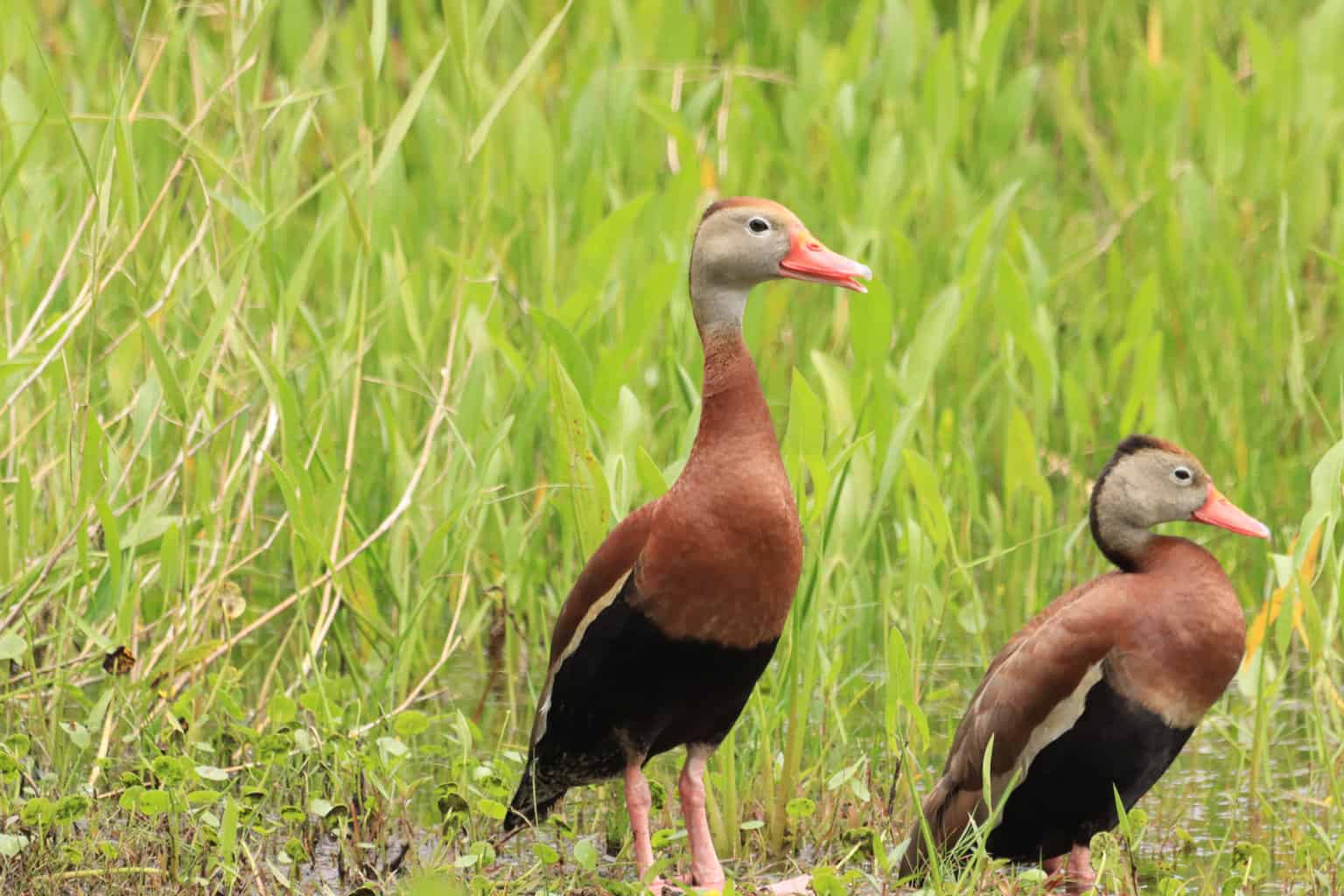
- Scientific Name: Dendrocygna autumnalis
- Length: 19-22 inches
- Weight: 1.4-2.2 pounds
- Wingspan: 30-37 inches
Black-Bellied Whistling Ducks are unlike most other Arkansas ducks because they are not sexually dimorphic. Instead, males and females have the same general appearance.
Both males and females are frequently described as being the color of cinnamon, with a dark pink bill. Their wings boast a long white stripe while in flight, and their legs are much longer than the average duck’s. Their faces are gray, and they get their name from their black bellies.
In Arkansas, you may find a Black-Bellied Whistling Duck nesting in the holes left behind by woodpeckers!
These birds have a shrill whistle that gives them the other part of their name. They can be found throughout the South, although they are more frequently found in Mexico and South America.
Blue-Winged Teal Duck (Dabbling Duck)
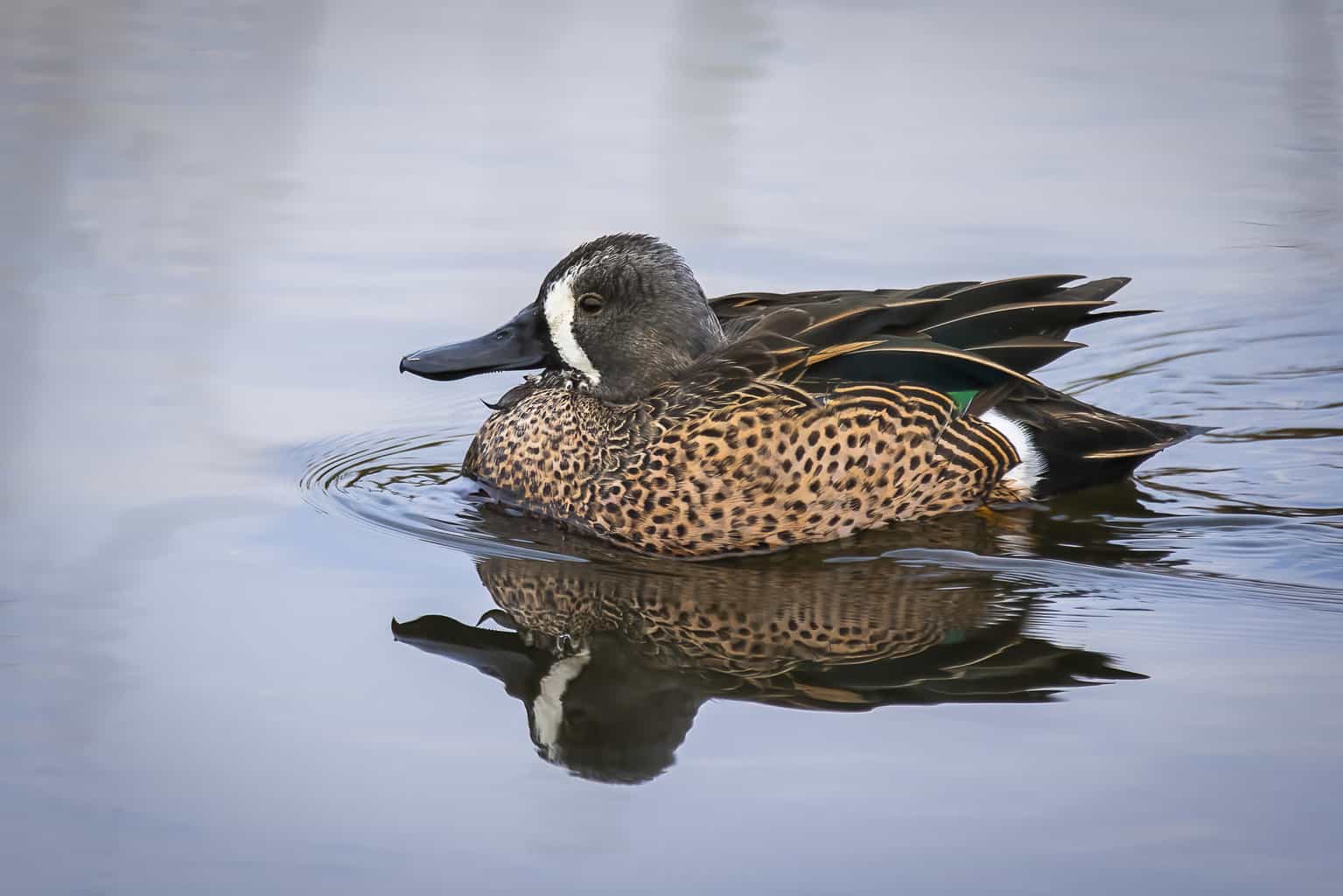
- Scientific Name: Anas discors
- Length: 16 inches
- Weight: 13 ounces
- Wingspan: 23 inches
The Blue-Winged Teal Duck migrates through Arkansas every September. You will most likely see a Blue-Winged Teal Duck in eastern Arkansas bayous or on the riverbanks. They are very common on the Mississippi River.
Some birds change their appearance depending on whether or not it is breeding season. During the breeding season, Blue-Winged Teal Duck males are primarily brown with speckled breasts and a white patch near their tail. Their head is grayish-blue, but a white strip runs from above their eye down the front of their face.
Females and non-breeding males have a similar appearance; they are plain brown with a blue patch on their wings that only shows up in flight.
Bufflehead (Diving Duck)
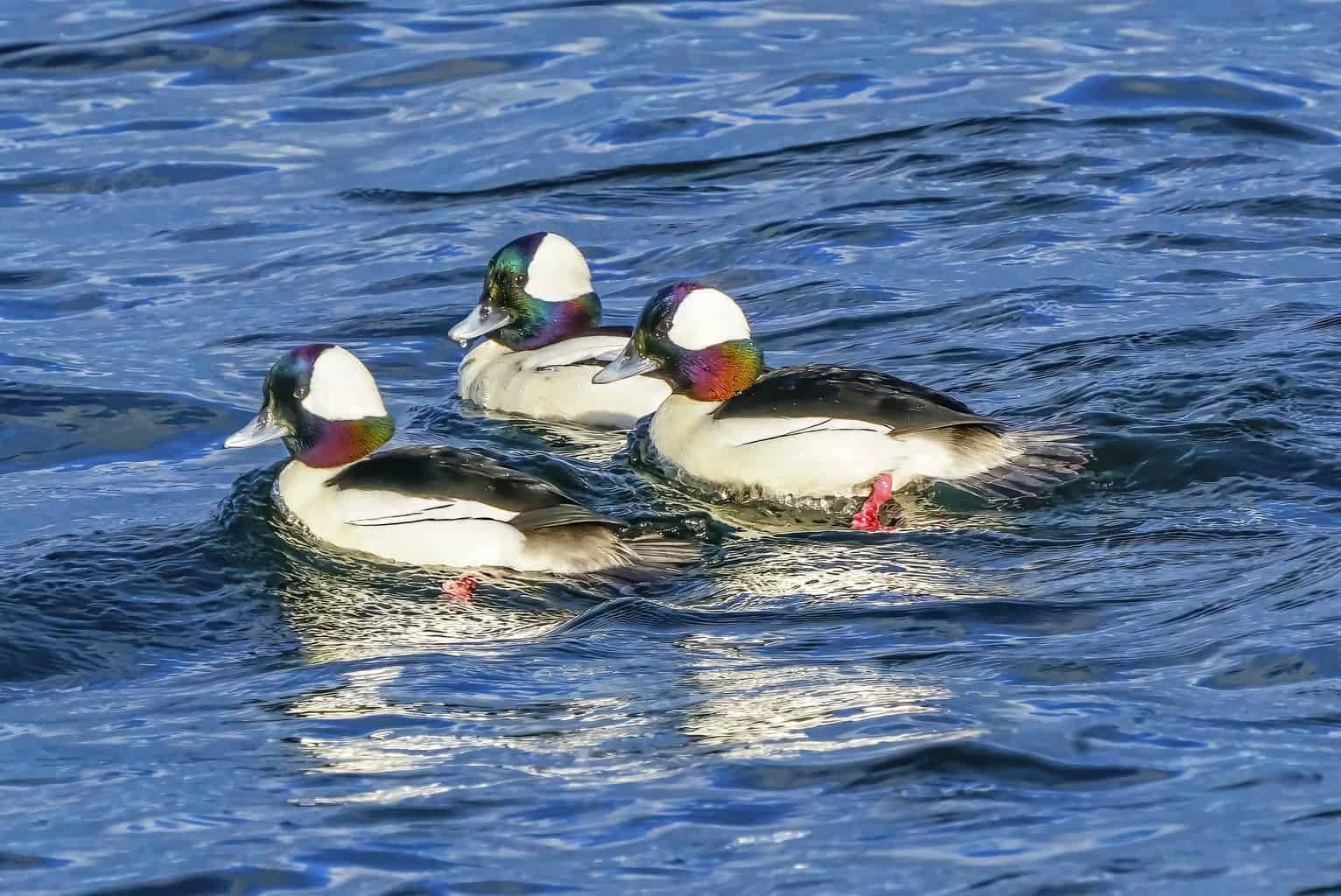
- Scientific Name: Bucephala albeola
- Length: 13-16 inches
- Weight: 11-16 ounces
- Wingspan: 22 inches
Buffleheads have a pretty great name and an even better appearance.
The Bufflehead is North America’s smallest diving duck. The adult male’s body is white, but its back is black, and its head is dark and iridescent. There is a very large white patch around the back of its head.
Females and juvenile males are brownish-gray and have a big, white, oval cheek patch.
These migratory ducks live and spend the winter in the southern half of North America, including Arkansas. They nest in the abandoned cavities left behind by Northern Flickers.
Canvasback (Diving Duck)
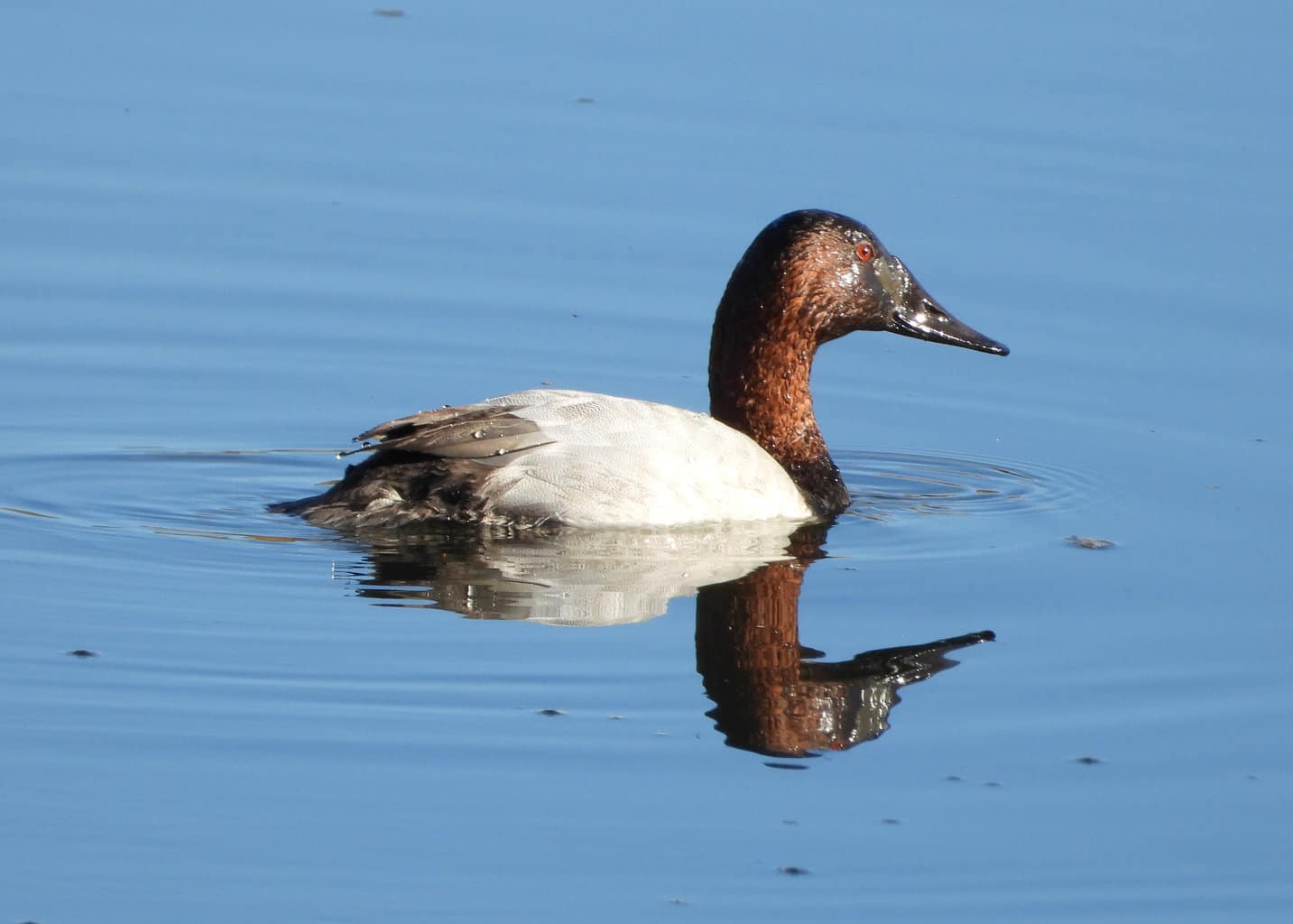
- Scientific Name: Aythya valisineria
- Length: 13-16 inches
- Weight: Up to 2.5 pounds
- Wingspan: Up to 3 feet
The Canvasback is a fast-flying diving duck that has been recorded flying up to 72 miles per hour. That’s nearly 30 miles per hour faster than the average duck.
They have big heads, thick necks, and long bills. The male is chestnut brown, black, and white, and the female is light brown. Another way to differentiate between a male and female Canvasback is that males’ eyes are red, and females’ eyes are dark.
Canvasbacks are only found in Arkansas during the non-breeding season. After spending the breeding seasons in lakes and ponds, they spend the winter in some of Arkansas’ deep freshwater lakes and coastal waterways.
One interesting Canvasback habit is that they will lay eggs in the nests of other female Canvasbacks. Meanwhile, they will hatch and raise babies for Redheads and Ruddy Ducks that lay their eggs in Canvasback nests!
Common Goldeneye (Diving Duck)
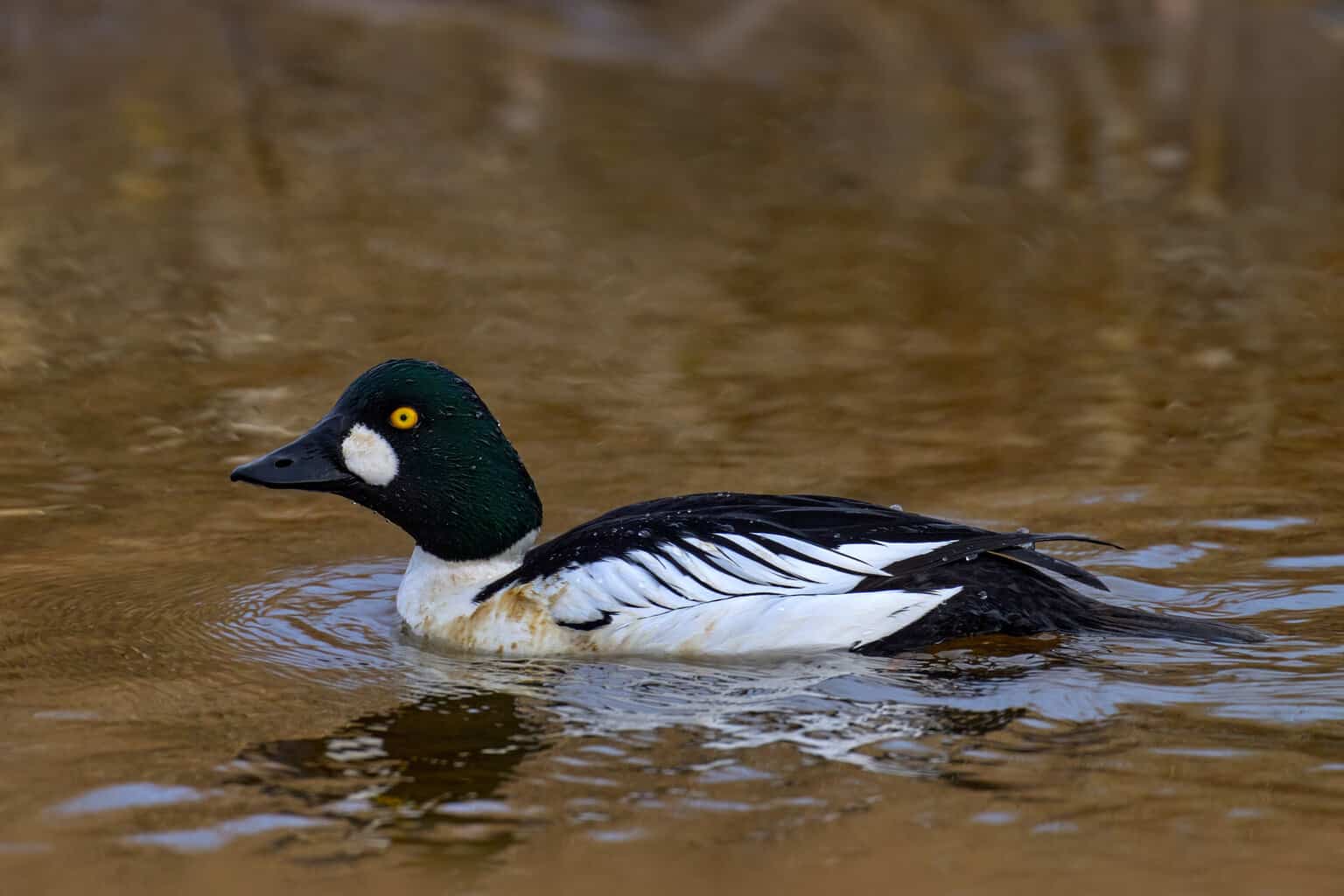
- Scientific Name: Bucephala clangula
- Length: 16-20 inches
- Weight: Approximately 1.8 pounds
- Wingspan: 30.3-32.7 inches
Goldeneye Ducks are immediately recognizable because of their bright yellow eyes. Males and females share this distinctive feature.
Males look black and white, but the black is very dark green. Females have mostly gray bodies with brown heads. Males and females alike have white patches on their wings.
In Arkansas, you will only see Goldeneye Ducks in the winter. Even in cold waters, they can dive as deep as seven feet below the surface. They’ll stay underwater for up to a minute before resurfacing, having feasted on insects, mussels, and aquatic plants.
Interestingly, Goldeneye hatchlings only stay in the nest for a single day! The day after hatching, they jump out of their nests, even those built into abandoned cavities up to 40 feet in the air! The female Goldeneye will call to her hatchlings, who jump out of the nesting cavity and fall to the ground.
Gadwall (Dabbling Duck)
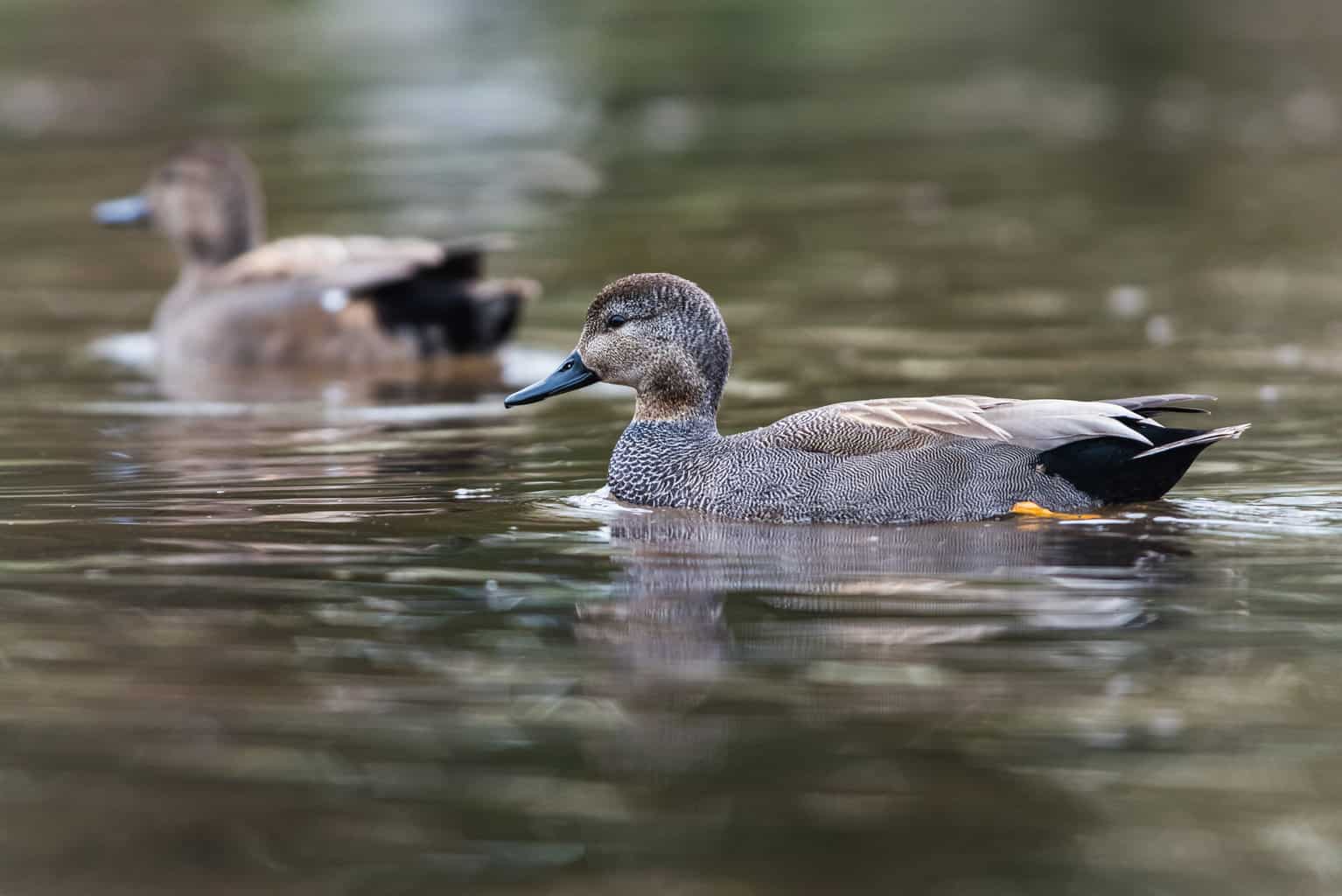
- Scientific Name: Mareca strepera
- Length: 18.1-22.4 inches
- Weight: 17.6-44.1 ounces
- Wingspan: 33.1 inches
The Gadwall Duck is a medium-sized bird with a somewhat square-shaped head and a thin neck and bill. Males are grayish-brown, and females are brown and off-white. When they’re swimming, males and females have a visible white patch on their wings.
Dabbling ducks typically prefer shallow water, but Gadwalls will make their way into deeper waters to get food. They blend into their surroundings and are hard to spot. In Arkansas, you will only see them in the non-breeding season, typically in the state’s marshes and estuaries. They also visit parks and even sewage ponds.
One of the most interesting things that Gadwall Ducks do is steal food from other ducks–specifically, diving ducks. They often live alongside American Coots and steal their food when they surface!
Greater Scaup (Diving Duck)
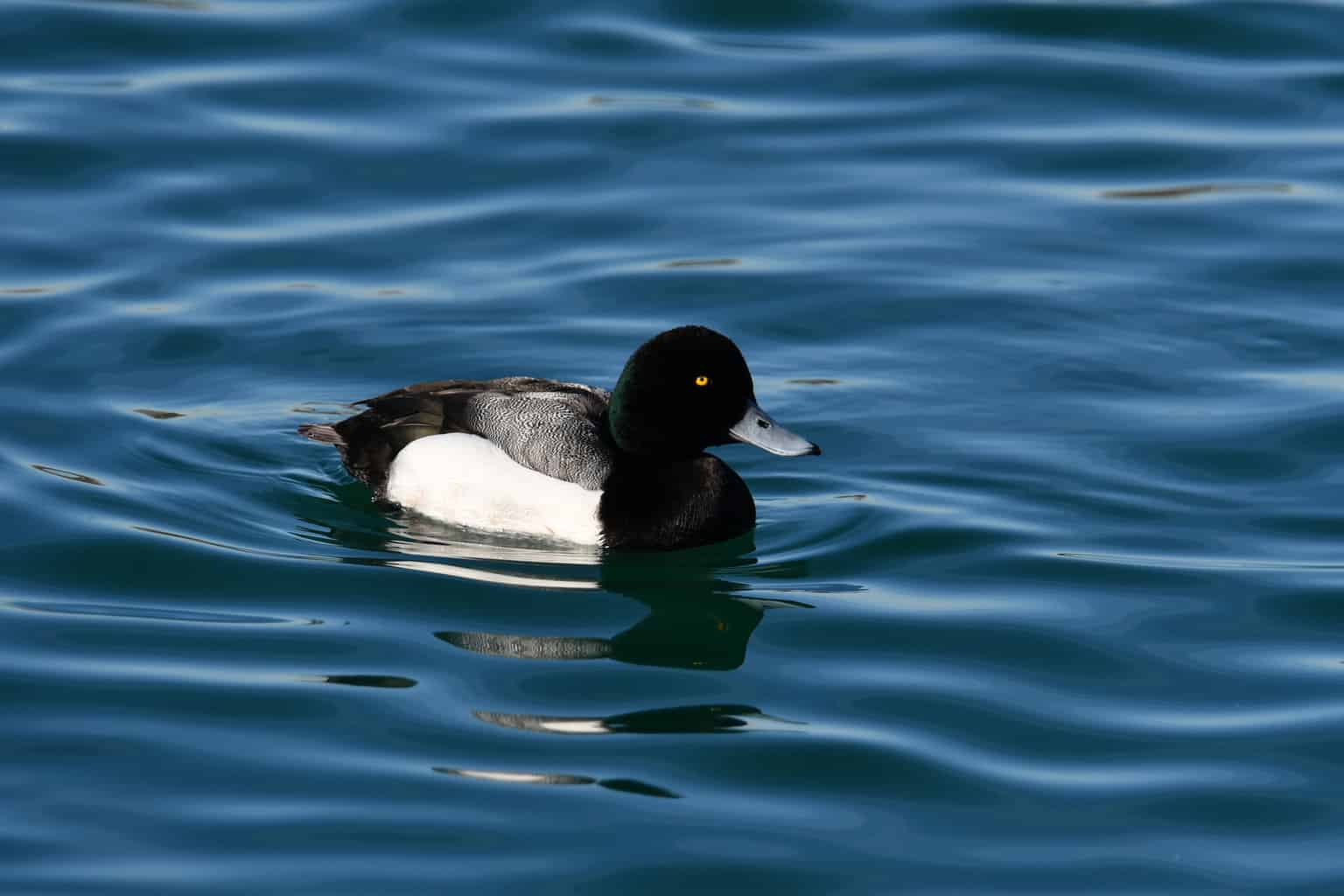
- Scientific Name: Aythya marila
- Length: 15-22 inches
- Weight: 1.5-2.9 pounds
- Wingspan: 28-33 inches
The Greater Scaup is also known as the Bluebill, thanks to its broad, blue-colored bill. The male Greater Scaup’s iridescent green feathers often appear black from a distance. The female is light brown with a dark brown head.
Although some non-breeding male ducks look almost identical to females, non-breeding Greater Scaups look like a hybrid between the breeding male and the female. His body is brown and gray, and his head is dark gray or almost black.
You will only find Greater Scaups in Arkansas during the winter. Arkansas is right at the southernmost edge of their migratory range. They travel all the way into the northern regions of Canada for their breeding season.
Green-Winged Teal Duck (Dabbling Duck)
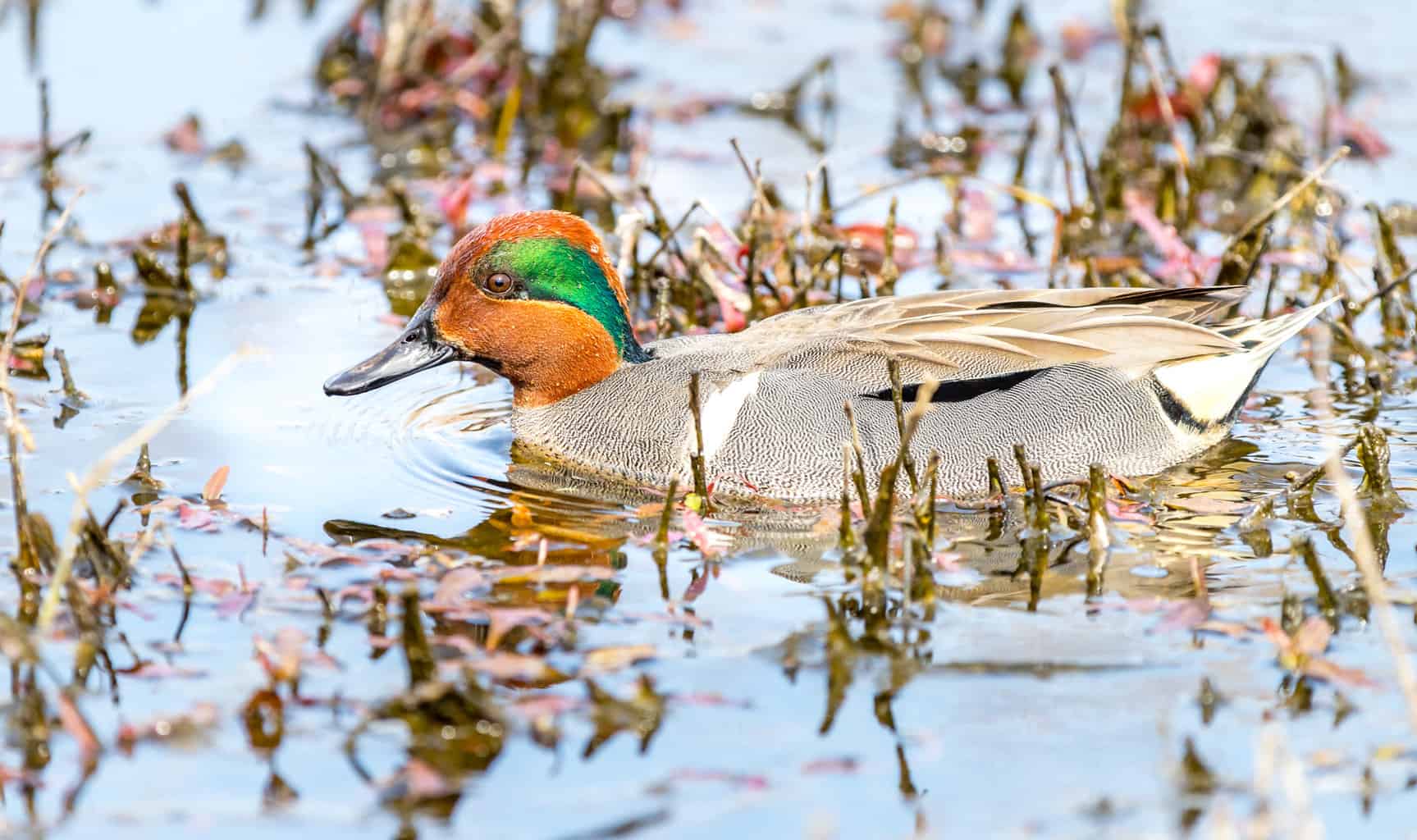
- Scientific Name: Anas carolinensis
- Length: 12.2-15.3 inches
- Weight: 4.9-17.6 ounces
- Wingspan: 20.5-23.2 inches
The male Green-Winged Teal Duck boasts a flashy head in shimmering green and dark coppery brown. Females are primarily brown. They are quite small, especially compared to most other ducks found in Arkansas. They are North America’s smallest dabbling duck.
Most of Arkansas’ ducks can be found in waterways, marshes, and estuaries, but Green-Winged Teal Ducks prefer flooded fields and river deltas. They will even spend time feeding in puddles.
Their summer breeding ground extends into the northernmost parts of Canada.
Hooded Merganser (Diving Duck)
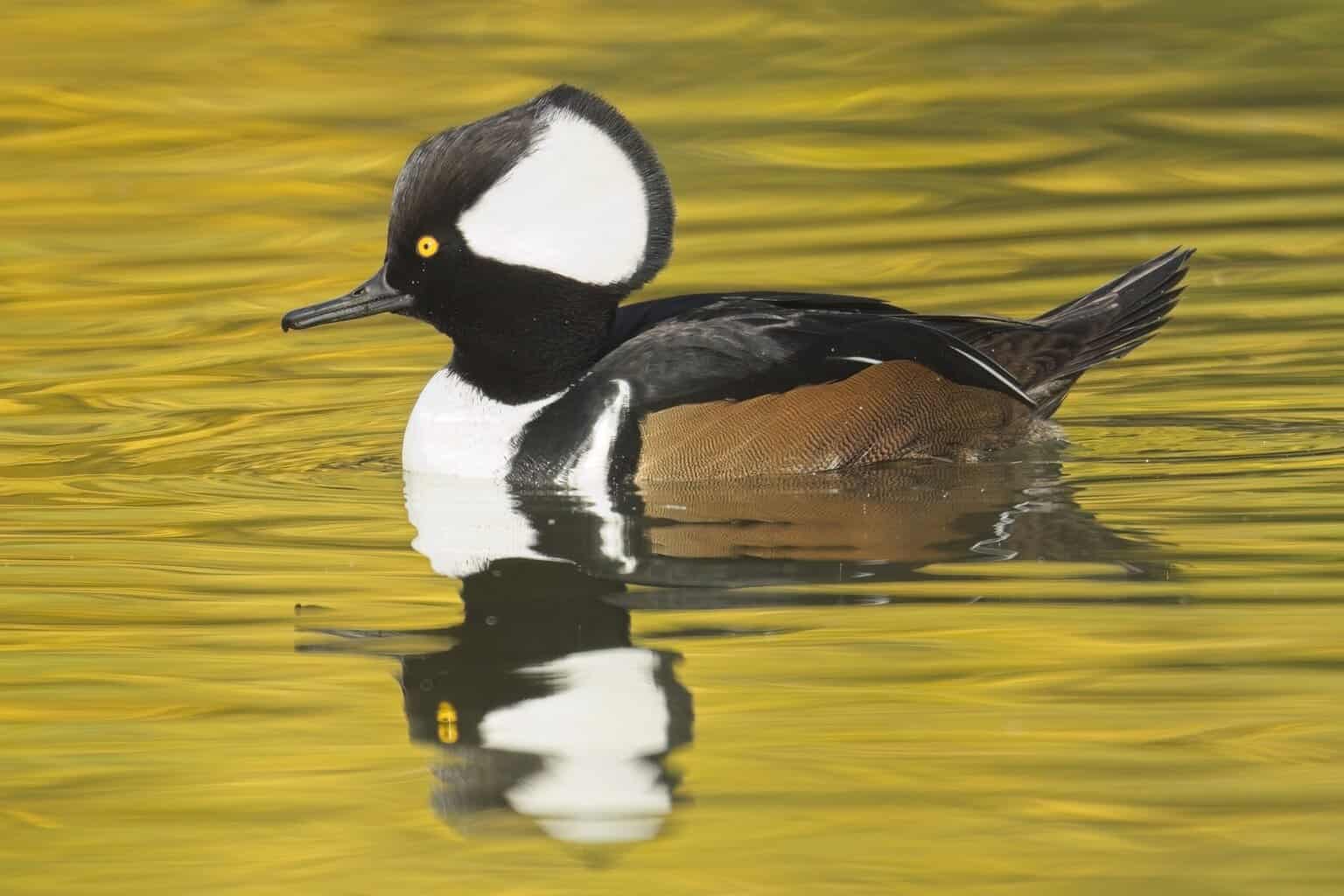
- Scientific Name: Lophodytes cucullatus
- Length: 15.8-19.3 inches
- Weight: 16-31 ounces
- Wingspan: 23.6-25 inches
Hooded Mergansers have a large, flashy crest atop their heads. Both males and females have this crest, although the male’s crest is more attention-grabbing contrasting black and white. The female’s crest is typically cinnamon in color.
Unlike many kinds of ducks only found in Arkansas in the winter, Hooded Mergansers are year-round residents of the western half of the state.
They have serrated bills, which they use to catch small fish, crayfish, and invertebrates. Like Goldeneyes, their babies leave the nest the day after they hatch.
Lesser Scaup (Diving Duck)
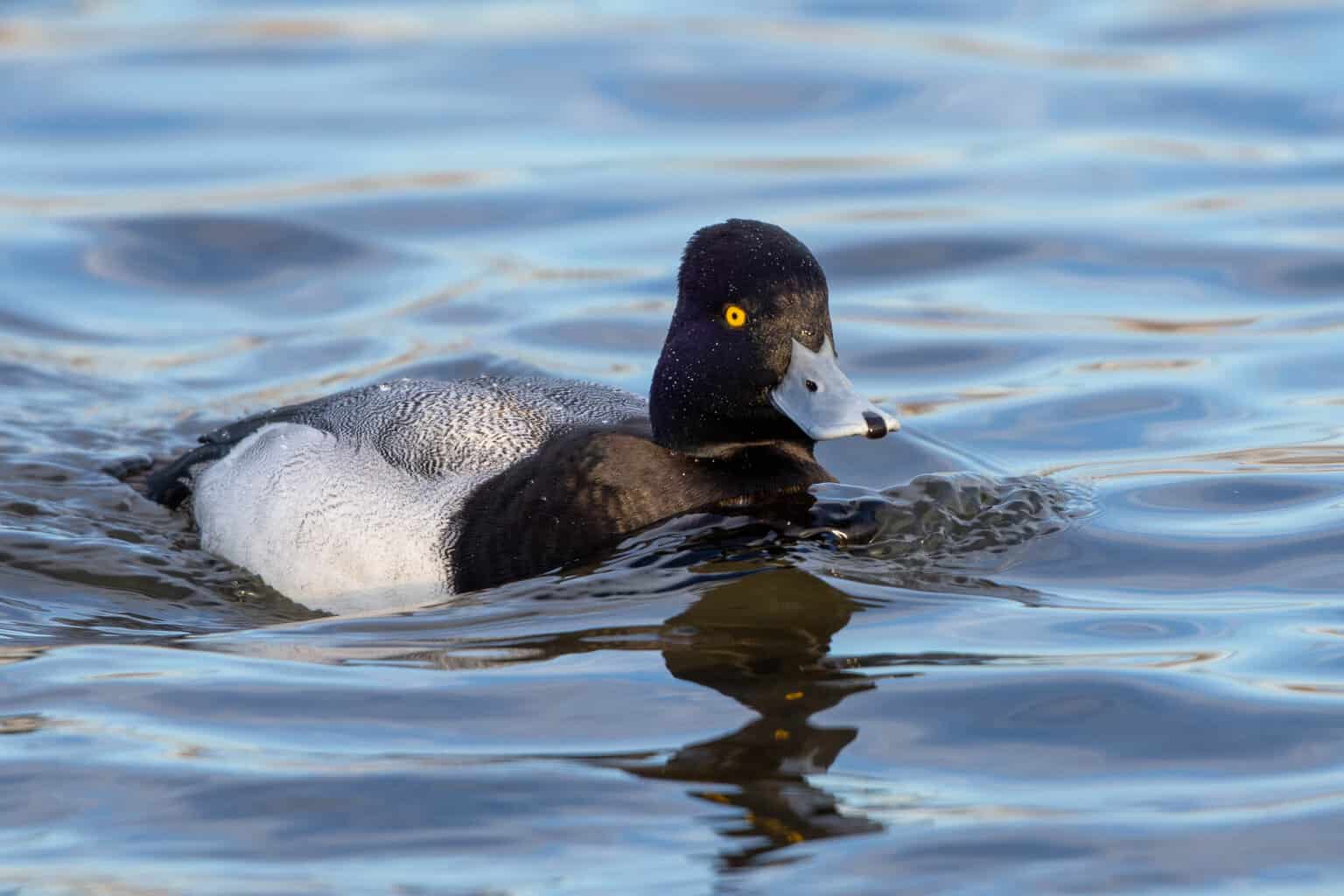
- Scientific Name: Aythya affinis
- Length: 15.3-18.1 inches
- Weight: 16-38.4 ounces
- Wingspan: 26.8-30.7 inches
Greater and Lesser Scaups look a lot alike, but there are a few subtle differences between them.
Males of both species appear black and white from a distance but are metallic green or purple. Females are similarly patterned but in different colors: dark brown head, lighter brown body, and sometimes a white patch by the bill. Like the Greater Scaup, non-breeding Lesser Scaup males look like a hybrid form of the female and a breeding male. His body is brown and gray, while his head is black.
Lesser Scaups will only be spotted in Arkansas in the winter. That’s good news because it’s easier to differentiate between the Greater and Lesser Scaup in winter, as they tend to choose different over-wintering habitats.
In the winter, Lesser Scaups prefer freshwater bodies, whereas Greater Scaups are more likely to choose saltwater.
Lesser Scaups may be slightly smaller, but individual Greater and Lesser Scaups can also be the same size. The Lesser Scaup tends to have larger clutches of eggs in each nest, raising 8-14 babies yearly. Greater Scaups raise 5-11 babies each breeding season. However, this won’t help you out in Arkansas, as Scaups breed in Canada.
The only significant visual difference is that the Greater Scaup has a rounder head, whereas Lesser Scaups have a more egg-shaped head.
Mallard (Dabbling Duck)
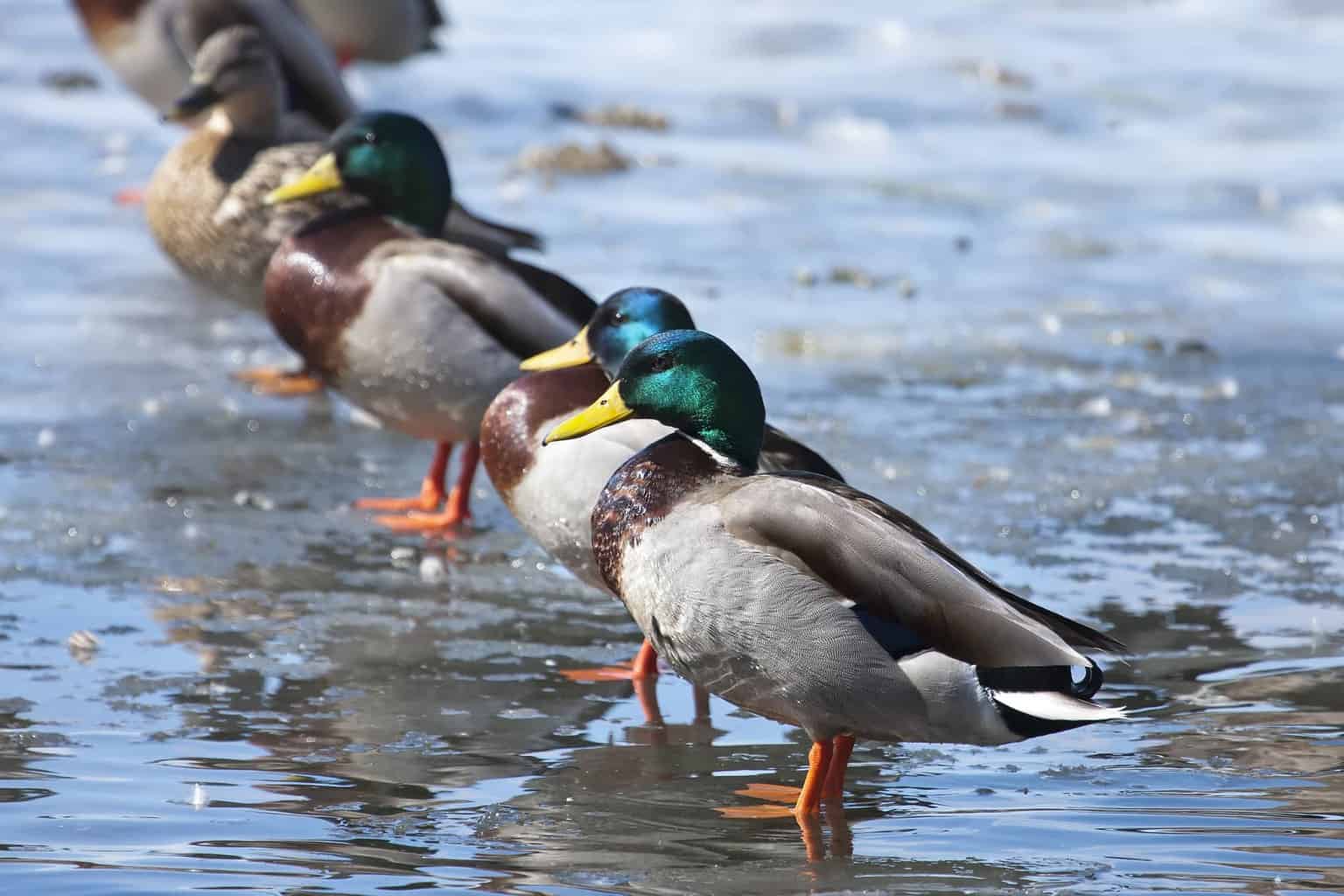
- Scientific Name: Anas platyrhynchos
- Length: 20-26 inches
- Weight: 1.5-3.5 pounds
- Wingspan: 32-39 inches
Mallards are some of the most famous and recognizable ducks in North America.
They are easily identified by the male’s very dark, shiny, iridescent green head and the female’s mottled brown and cream body. The male also boasts a bright white ring around his neck, which provides a stark contrast between the dark green head and brown body.
Most domesticated ducks in North America are descendants of Mallards, thanks to the Mallard duck’s habit of breeding with other kinds of ducks.
Mallards are common in Arkansas in winter and can be spotted throughout the state. In fact, more mallards overwinter in Arkansas than in any other state.
Mottled Duck (Dabbling Duck)
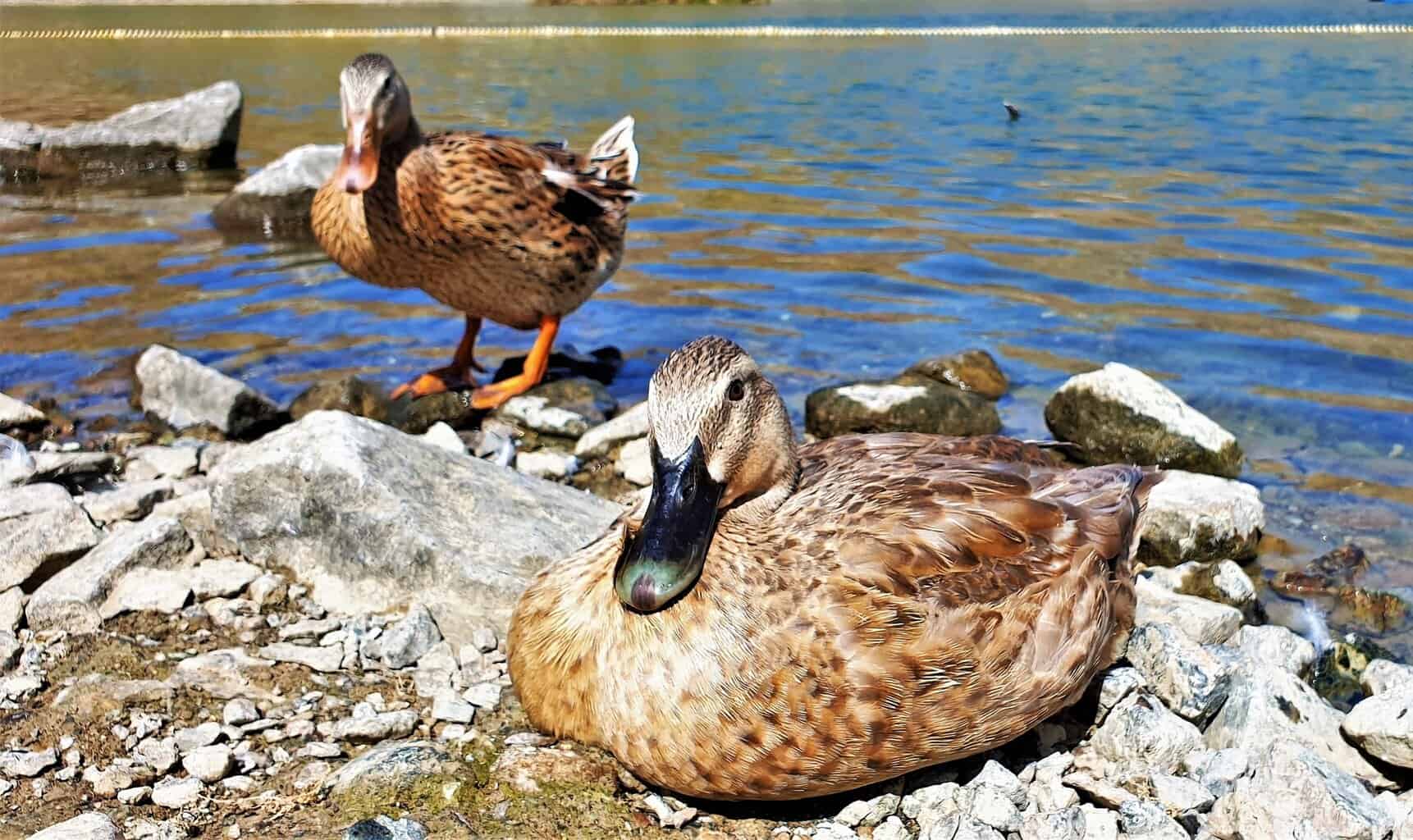
- Scientific Name: Anas fulvigula
- Length: 18.5-21 inches
- Weight: 24.7-40.6 ounces
- Wingspan: 31.5-34.3 inches
There are few differences between male and female Mottled Ducks. They both have light and dark brown bodies, yellow bills, and streaked feathers over most of their bodies. Females have a bit less color, sometimes looking greenish-yellow.
There is a common hybrid of Mottled and Mallard Ducks called a “Muddled Duck,” but these hybrids live only in Florida.
Mottled Ducks stick to freshwater sources, including rivers, retaining ponds, ditches, marshes, reservoirs, and even large field puddles.
These ducks have a very small range. Unlike their long-distance migratory cousins, Mottled Ducks limit themselves to Florida and the coast along the Gulf of Mexico. Some will migrate just a few hundred miles to east Texas for the breeding season.
If they are spotted in Arkansas, it is because they are outside of their normal behavior. However, they have been seen in Arkansas’ rivers and ponds.
Northern Pintail (Dabbling Duck)
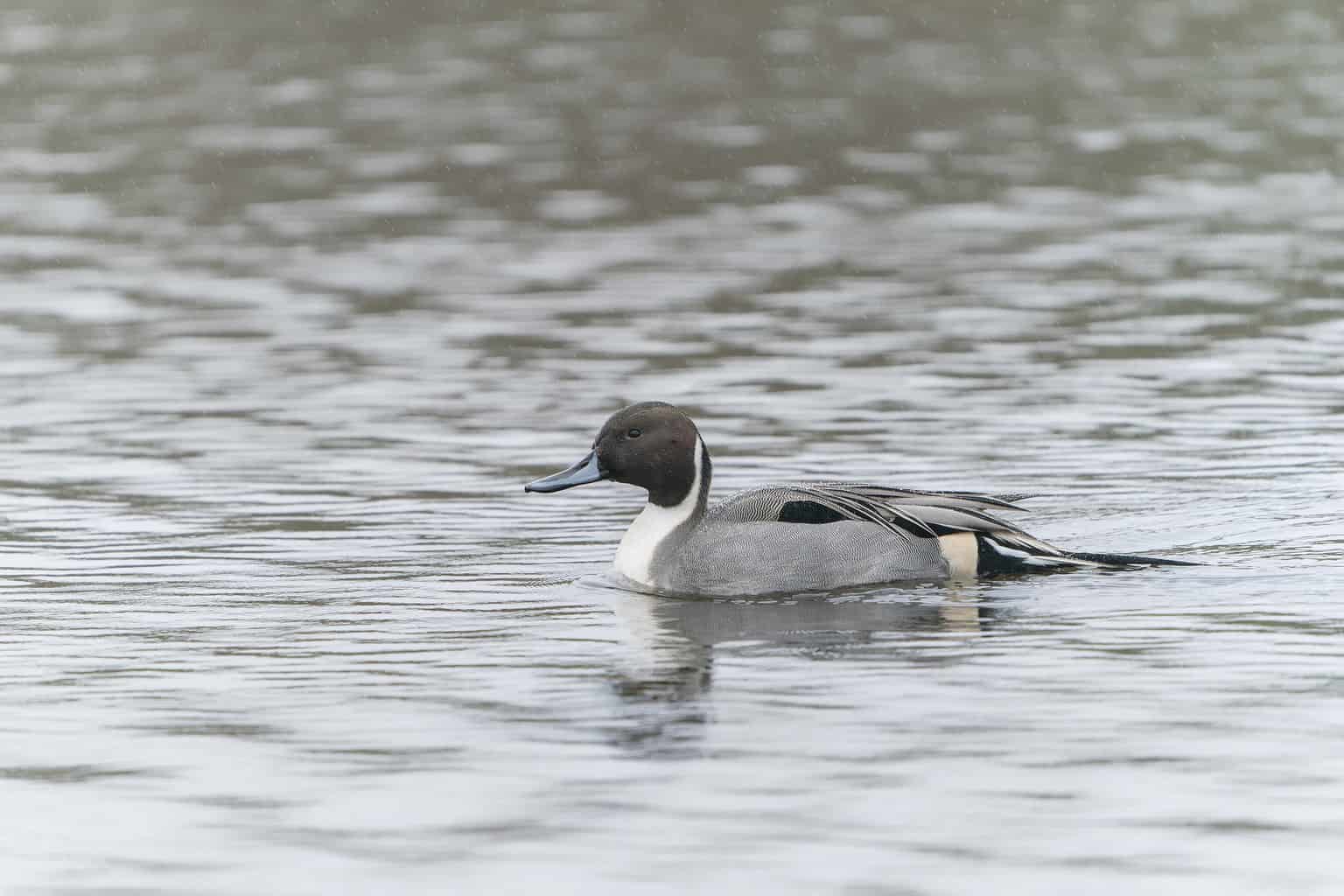
- Scientific Name: Anas acuta
- Length: 20-30 inches
- Weight: 1-3 pounds
- Wingspan: 20-30 inches
The Northern Pintail gets its name from its thin, pointy tail that is very different from most other ducks’ short, stocky tails. But, only breeding males have this very long tail. Non-breeding males and females have a more familiar duck-shaped silhouette.
Breeding males also have bright white breasts and dark brown necks and heads. A white line runs down their head and neck, dividing the brown into two areas. Females have plain, very light brown faces with no markings.
Males also have a green speculum, which is the term for inner wing feathers. Females have a metallic brown speculum.
Pintails spend winter in Arkansas, specifically in freshwater ponds, rivers, marshes, and retaining pools. They get to Arkansas by flying up to 48 miles per hour during their nighttime migration from Canada. Northern Pintails are not strictly North American ducks; they can also be found in Europe.
Northern Shoveler (Dabbling Duck)

- Scientific Name: Spatula clypeata
- Length: 19 inches
- Weight: 1.3 pounds
- Wingspan: 30 inches
You can identify a Northern Shoveler by looking at its broad, shovel-shaped bill that gives it its name.
Breeding-season males have bright coloring: stark white, light blue, iridescent green, and shiny brown. They also have a blue speculum on their wings. Males have a black bill.
Females and juvenile males are mottled brown and cream, with a slight tinge of blue on their wings. Females have a vibrant orange bill. One interesting–and kind of gross–habit of the female Northern Shoveler is that she will defecate on her eggs and nest when a predator is attacking. She does this as she is fleeing, in hopes of deterring the predator from eating her eggs.
Northern Shovelers are found in North America, Europe, Africa, and India.
Like many other ducks on this list, Northern Shovelers only spend the winter in Arkansas. Their nests can be found in tall grasses, and they forage for insects, small fish, crustaceans, and aquatic plants in coastal waters, including wetlands, marshes, lakes, and lagoons.
Redhead (Diving Duck)
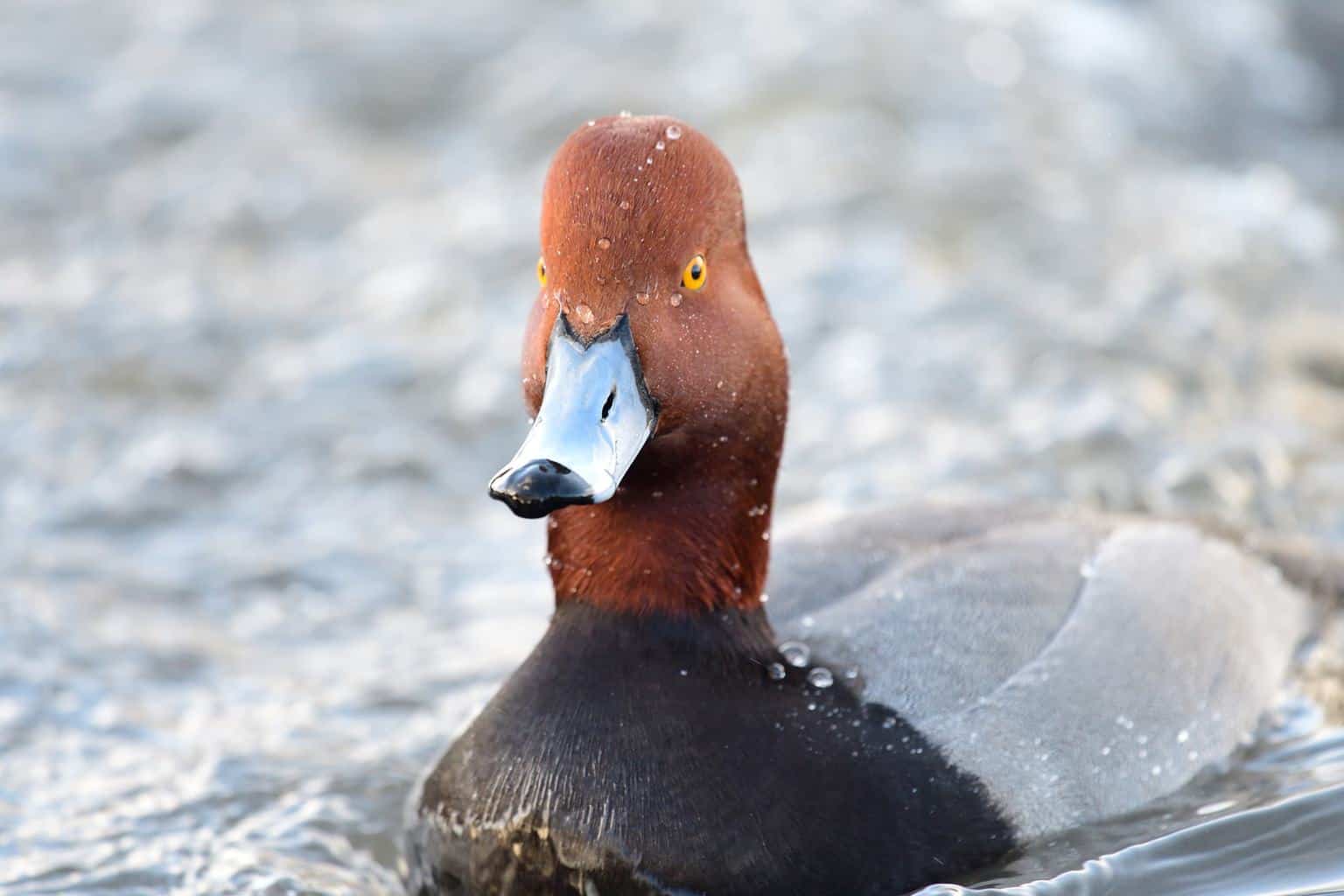
- Scientific Name: Aythya americana
- Length: 18-22 inches
- Weight: 2-2.5 pounds
- Wingspan: 33 inches
Second only to the Mallard, the Redhead duck is one of the easiest ducks to recognize from a distance, thanks to its dark, cinnamon-brown head and black breast. Females are very plain in light brown, with little variation in their feathers from head to tail.
Redhead males and females have rounded heads and gray wing feathers that are primarily visible in flight.
Arkansas sees Redheads gather in the thousands–the largest documented flock numbered over 60,000 Redhead ducks! Watch for Redhead ducks in areas like Lake Ouachita, Bull Shoals Lake, and Lake Dardanelle.
Red-Breasted Merganser (Diving Duck)
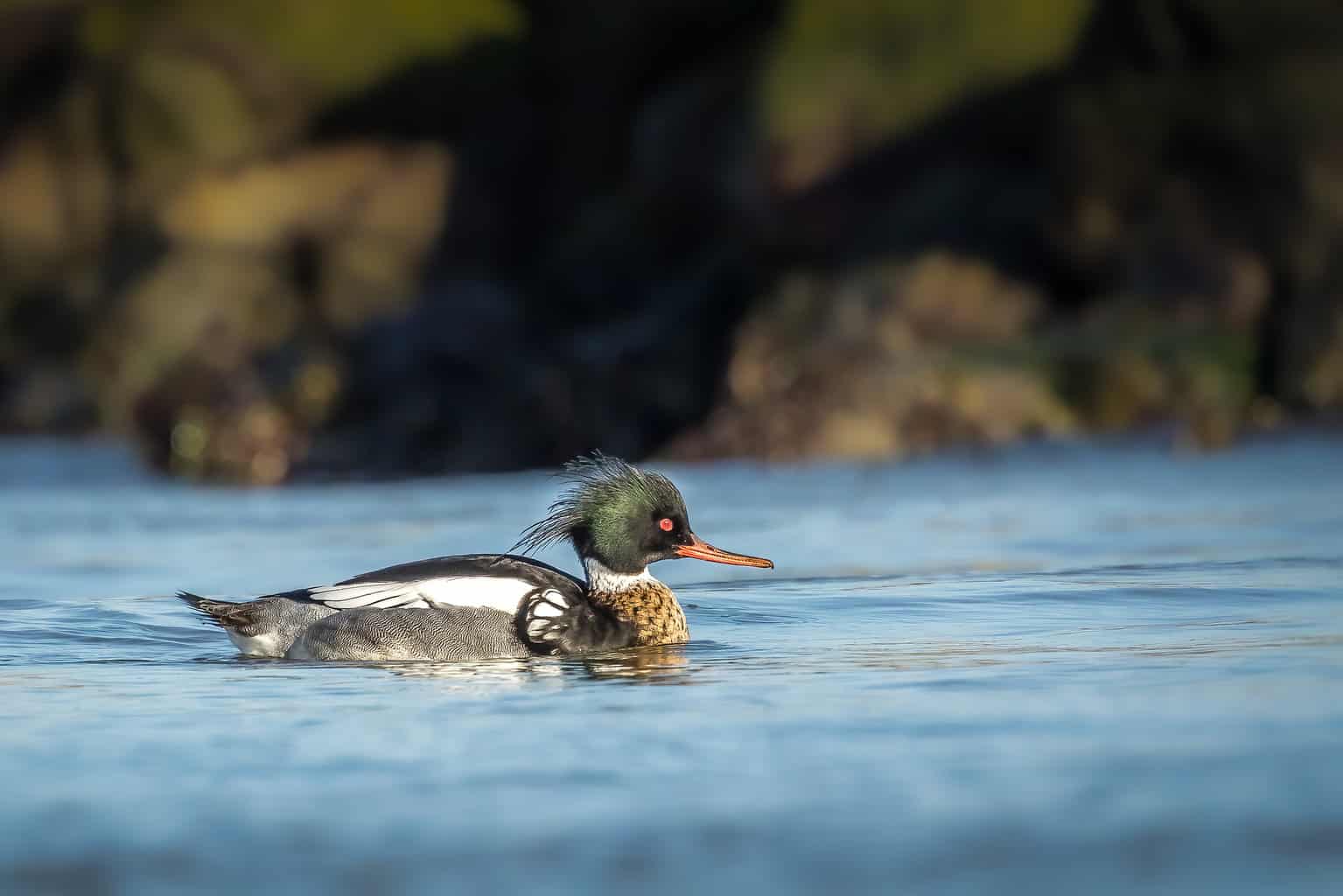
- Scientific Name: Mergus serrator
- Length: 20-24 inches
- Weight: 2.3 pounds
- Wingspan: 28-34 inches
This is one of the coolest and most unique-looking ducks on our list!
Male and female Red-Breasted Mergansers have long, shaggy feathers forming a crest at the back of their heads. Males’ heads are greenish-black, and females’ are light brown. Males are cinnamon-brown in the chest and have a thick white band around the neck.
Females and juvenile males have light gray-brown bodies and brown heads. They do not have that flashy white neckband that adult males have.
They spend winters in either saltwater or freshwater sources, but they prefer saltwater.
Mergansers are migratory and may pass through Arkansas on their way to and from their summer breeding grounds in northern Canada. They spend the winters along the east and west coasts of North America, and the Gulf of Mexico.
Red-breasted Mergansers migrate during the day, so you may be able to see them on their way!
Ring-Necked Duck (Diving Duck)
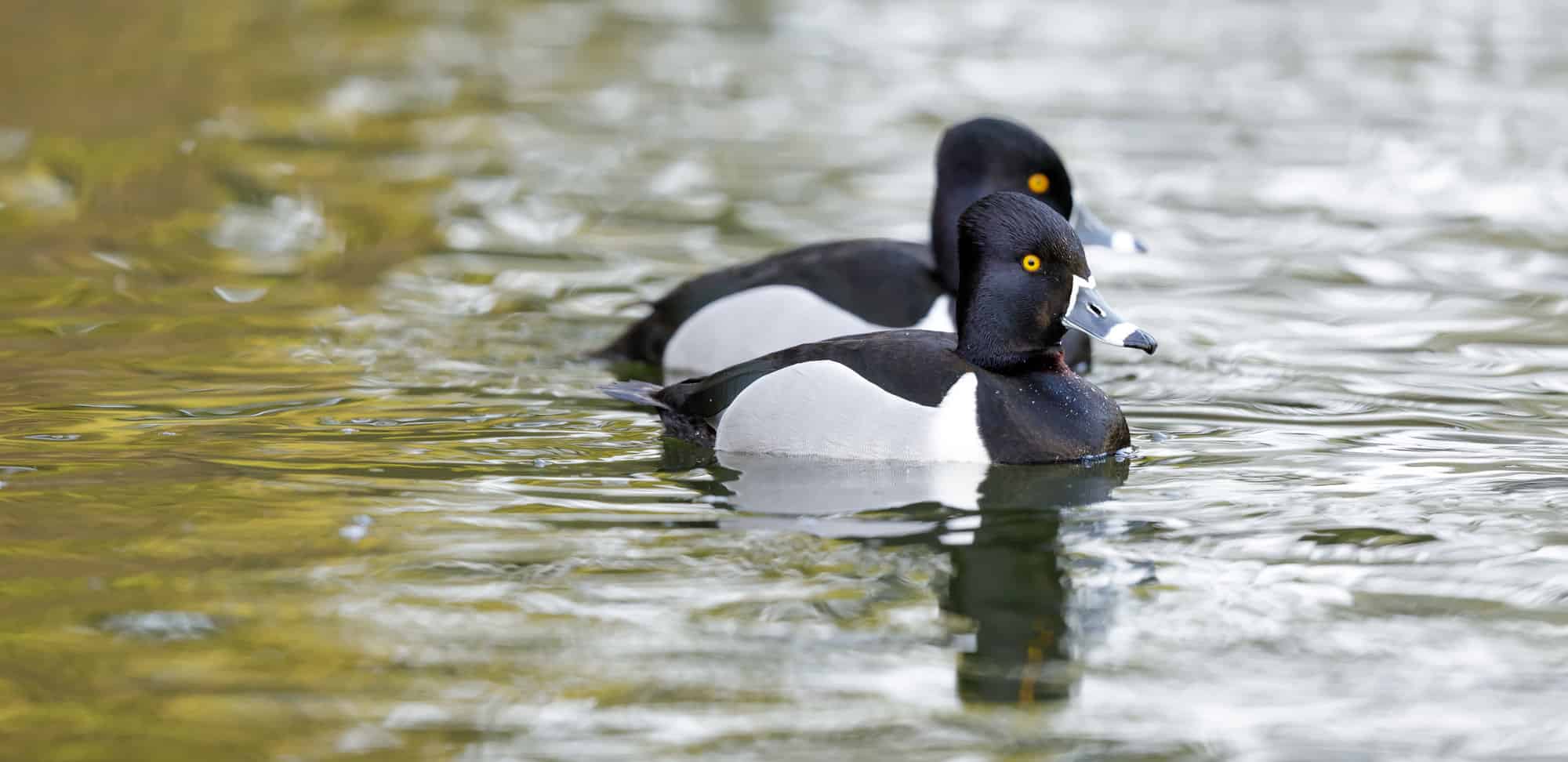
- Scientific Name: Aythya collaris
- Length: 15.3-18.1 inches
- Weight: 17.3-32.1 ounces
- Wingspan: 24.4-24.8 inches
The Ring-Necked Duck sounds like it would have a visible ring around its neck, right? Well, not exactly.
A male Ring-Necked Duck does have a ring around his neck, but it is very difficult to see because it is a dark, chestnut brown ring on an otherwise black neck. The story is that this brown ring is very difficult to spot from a distance or even up close, but it was quite noticeable to the biologists who first described this species in the 1800s.
Interestingly, they do have a noticeable white ring around their bill.
Their foreheads slope downward from the top of their head, which has a small crown.
Even though they are diving ducks, Ring-Necked Ducks prefer to live in smaller, shallower bodies of water. They may be found in small ponds, lakes, marshes, and fields throughout Arkansas during the winter.
Ruddy Duck (Diving Duck)
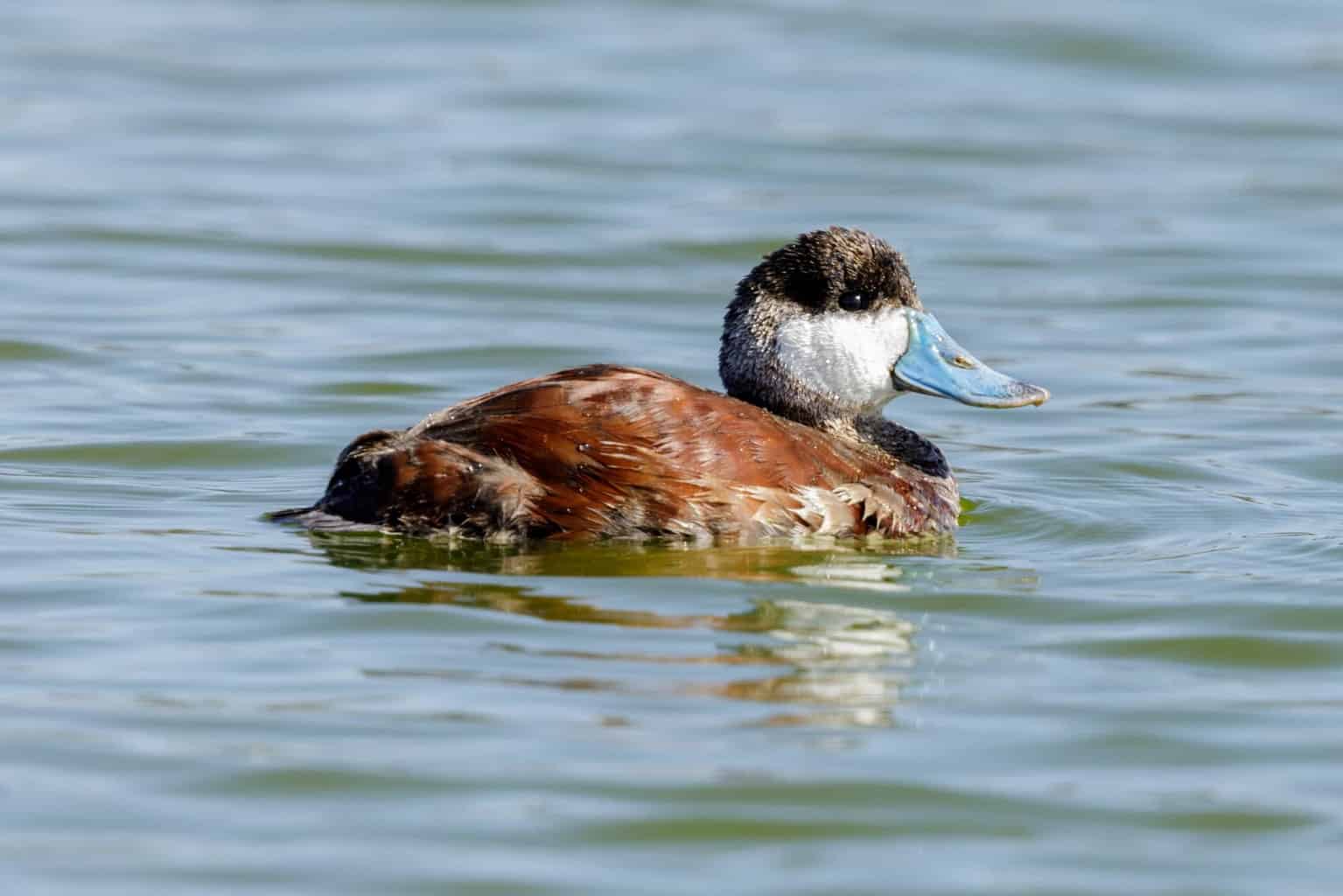
- Scientific Name: Oxyura jamaicensis
- Length: 13.5-17 inches
- Weight: 1.23 pounds
- Wingspan: 18.5 inches
If you see a male Ruddy Duck in the summer, you should be able to identify it quickly from its thick and vibrant blue bill. Unfortunately for people in Arkansas, the Ruddy Duck is only here in the winter, when his bill is black. The female’s bill is always black.
Males have black heads with a large white cheek area. Juvenile males and females are light brown, with a dark crown. Breeding males have another interesting feature: a long, pointy tail. It’s not as pronounced as a Pintail, but it’s still noticeable in the summer.
Only some areas of Arkansas are home to wintering Ruddy Ducks. You’ll find them to the east of SR 67 and I-30 throughout the winter. You’ll likely only see west of that line during their migration period, when they travel to Great Plains states and Canada to breed.
Wood Duck (Dabbling Duck)
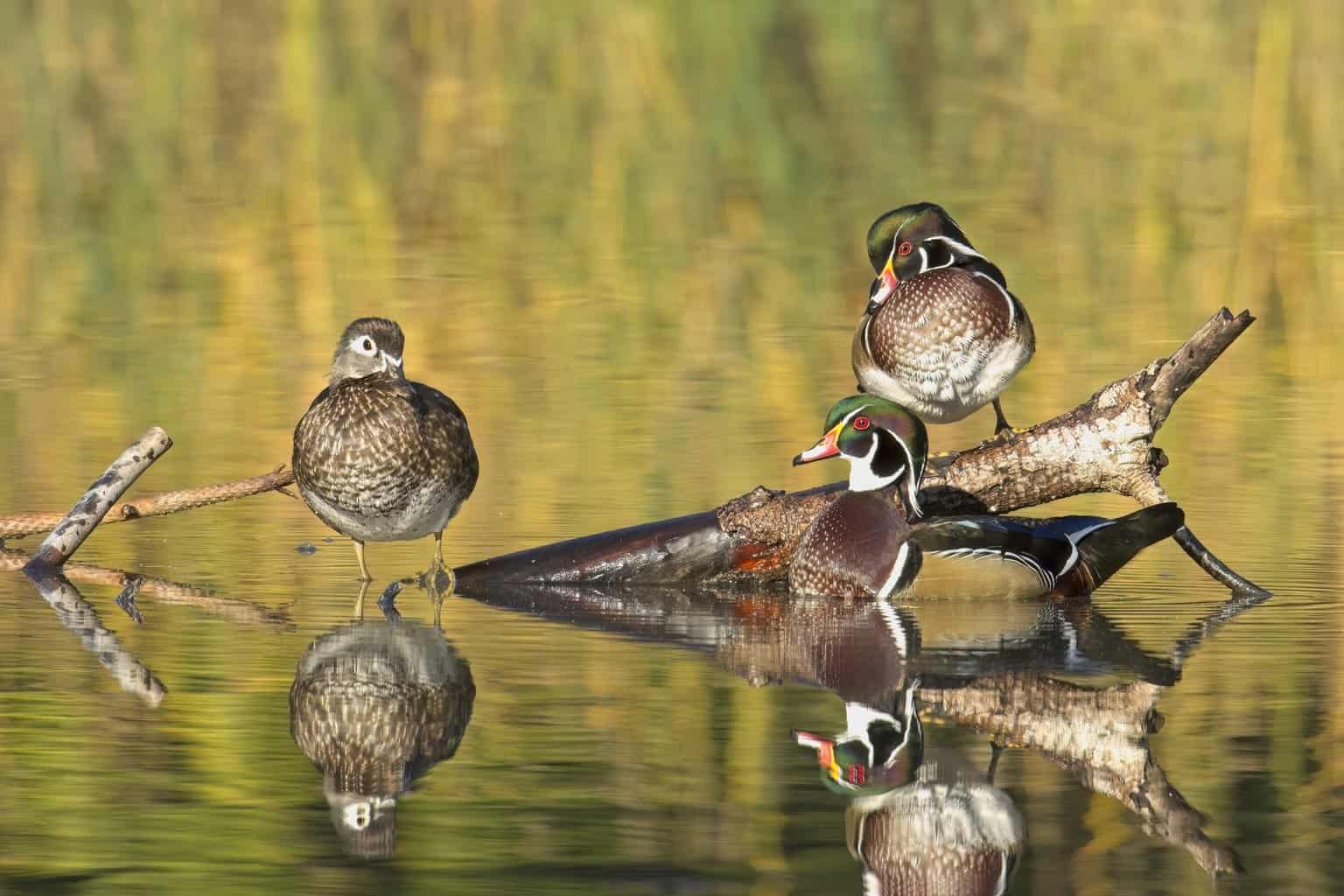
- Scientific Name: Aix sponsa
- Length: 17-20 inches
- Weight: 1.5 pounds
- Wingspan: 28 inches
With its flashy and dramatic color pattern, the Wood Duck is a great duck to wrap up this list.
Male Wood Ducks have a dark, shiny green head with several distinct white stripes from the bill to the back of the head. Their chestnut brown breast is spotted in small white pin dots. Females have the same spotted chest, but their overall color is grayish-brown.
During the winter, male Wood Ducks lose those colorful markings and appear mostly brownish-gray. Their multi-colored bill is bright all year long.
Wood Ducks are one of Arkansas’ only year-round ducks! You can find them nesting around rivers, swamps, wetlands, marshes, and ponds, especially where there are cattails. They build their nests in trees, typically in the abandoned cavities left behind by other birds and animals.
Final Thoughts
Arkansas is home to so many incredible birds, including hummingbirds, blackbirds, orioles, birds of prey, meadowlarks, and, of course, ducks!
From the ducks we see only in winter to the ducks that live here year-round, Arkansas is a great place to watch for interesting and unusual ducks.
The next time you’re visiting Arkansas’ wetlands, marshes, rivers, ponds, or even a city park, look for some of these varieties of ducks in and along the water!

